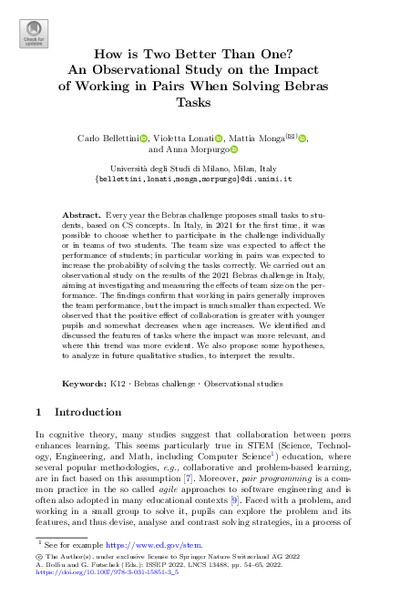How is Two Better Than One?An Observational Study on the Impact of Working in Pairs When Solving Bebras Tasks
|
 |
 Diese Seite wurde seit 3 Jahren inhaltlich nicht mehr aktualisiert.
Unter Umständen ist sie nicht mehr aktuell.
Diese Seite wurde seit 3 Jahren inhaltlich nicht mehr aktualisiert.
Unter Umständen ist sie nicht mehr aktuell.
 Zusammenfassungen
Zusammenfassungen
 Every year the Bebras challenge proposes small tasks to students, based on CS concepts. In Italy, in 2021 for the first time, it was possible to choose whether to participate in the challenge individually or in teams of two students. The team size was expected to affect the performance of students; in particular working in pairs was expected to increase the probability of solving the tasks correctly. We carried out an observational study on the results of the 2021 Bebras challenge in Italy, aiming at investigating and measuring the effects of team size on the performance. The findings confirm that working in pairs generally improves the team performance, but the impact is much smaller than expected. We observed that the positive effect of collaboration is greater with younger pupils and somewhat decreases when age increases. We identified and discussed the features of tasks where the impact was more relevant, and where this trend was more evident. We also propose some hypotheses, to analyze in future qualitative studies, to interpret the results.
Every year the Bebras challenge proposes small tasks to students, based on CS concepts. In Italy, in 2021 for the first time, it was possible to choose whether to participate in the challenge individually or in teams of two students. The team size was expected to affect the performance of students; in particular working in pairs was expected to increase the probability of solving the tasks correctly. We carried out an observational study on the results of the 2021 Bebras challenge in Italy, aiming at investigating and measuring the effects of team size on the performance. The findings confirm that working in pairs generally improves the team performance, but the impact is much smaller than expected. We observed that the positive effect of collaboration is greater with younger pupils and somewhat decreases when age increases. We identified and discussed the features of tasks where the impact was more relevant, and where this trend was more evident. We also propose some hypotheses, to analyze in future qualitative studies, to interpret the results. Dieser wissenschaftliche Zeitschriftenartikel erwähnt ...
Dieser wissenschaftliche Zeitschriftenartikel erwähnt ...
 Personen KB IB clear | Avi Cohen , Valentina Dagiene , Valentina Dagienė , Bruria Haberman | |||||||||||||||||||||||||||
 Begriffe KB IB clear | Informatik-Biber
,  Partnerarbeit Partnerarbeit
| |||||||||||||||||||||||||||
 Bücher |
| |||||||||||||||||||||||||||
 Texte |
|
 Dieser wissenschaftliche Zeitschriftenartikel erwähnt vermutlich nicht ...
Dieser wissenschaftliche Zeitschriftenartikel erwähnt vermutlich nicht ... 
 Nicht erwähnte Begriffe | Einzelarbeit |
 Zitationsgraph
Zitationsgraph
 Zitationsgraph (Beta-Test mit vis.js)
Zitationsgraph (Beta-Test mit vis.js)
 Anderswo finden
Anderswo finden
 Volltext dieses Dokuments
Volltext dieses Dokuments
 |  How is Two Better Than One? An Observational Study on the Impact of Working in Pairs When Solving Bebras Tasks: Artikel als Volltext @ Springer ( How is Two Better Than One? An Observational Study on the Impact of Working in Pairs When Solving Bebras Tasks: Artikel als Volltext @ Springer ( : :  , 352 kByte; , 352 kByte;  : :  ) ) |
 Anderswo suchen
Anderswo suchen 
 Beat und dieser wissenschaftliche Zeitschriftenartikel
Beat und dieser wissenschaftliche Zeitschriftenartikel
Beat hat Dieser wissenschaftliche Zeitschriftenartikel während seiner Zeit am Institut für Medien und Schule (IMS) ins Biblionetz aufgenommen. Er hat Dieser wissenschaftliche Zeitschriftenartikel einmalig erfasst und bisher nicht mehr bearbeitet. Beat besitzt kein physisches, aber ein digitales Exemplar. Eine digitale Version ist auf dem Internet verfügbar (s.o.). Aufgrund der wenigen Einträge im Biblionetz scheint er es nicht wirklich gelesen zu haben. Es gibt bisher auch nur wenige Objekte im Biblionetz, die dieses Werk zitieren.









 Biblionetz-History
Biblionetz-History